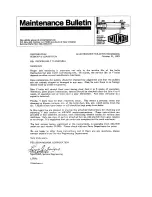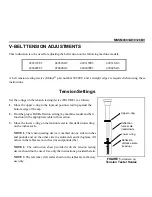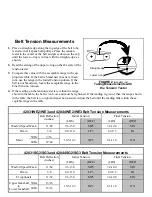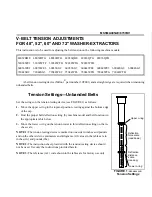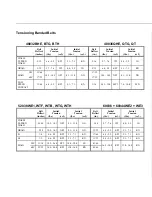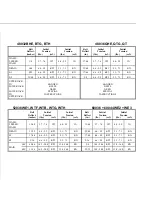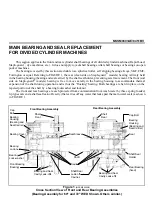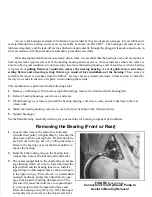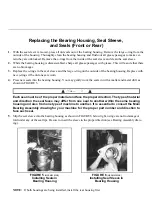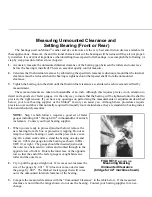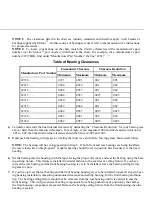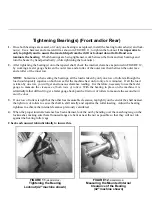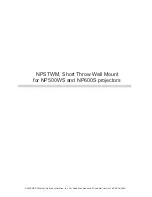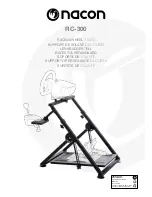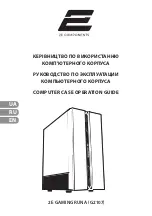
MSSM0303AE/8451BV (1 of 5)
È
MAIN BEARING AND SEAL REPLACEMENT
FOR DIVIDED CYLINDER MACHINES
This section applies to the front and rear cylinder shaft bearings of all divided cylinder machines (Rapid Load,
Staph-guard
®
, dye machines, etc.). It does not apply to jackshaft bearings, idler shaft bearings or bearings on open
pocket machines.
The bearings covered by this section are double row, spherical roller, self aligning bearings; Koya, SKF, FMC,
Torrington or equal. Referring to FIGURE 1, the rear (clean side on Staph-guard
®
models) bearing is firmly held
in the bearing housing (bearing and seal carrier) by the shaft seal holder, preventing axial movement. The front (soil
side on Staph-guard
®
models) bearing is free to move axially in the bearing housing to accommodate thermal
expansion of the shaft during operation and is thus the “floating” bearing. Both bearings are held in place on the
tapered portion of the shaft by a bearing lockwasher and locknut.
The front and rear bearings are each protected from contamination from wash water by three spring loaded,
lip type seals and a shaft seal leak-off cavity (that carries off any water that leaks past the main water seals) as shown
in FIGURE 1.
Access to the bearings and seals for lubrication is provided by the various grease passages. Excess lubricant is
excreted through the bearing and seal cavity leak-offs as shown on FIGURE 1. The bearings and seals must be
lubricated regularly and the leak-off cavities flushed out periodically through the plugged cleanout connections, in
strict accordance with the preventive maintenance procedures elsewhere.
If bearing replacement becomes necessary due to wear, it is essential that the bearings and seals are replaced.
Seal replacement requires removal of the bearing housing and seal sleeve. (In rare instances where the seals are
known to be in good condition, it is not necessary to remove the bearing housing, seals or seal sleeve when a bearing
is replaced.) A pulling fixture is required to remove the bearing housing. A set of guide rods, a seal sleeve
setting fixture and a bearing setting fixture are required for reinstallation of the housing. These tools are
available for rental or purchase from the Milnor
®
factory and are pictured elsewhere in this section. Contact the
factory two weeks in advance of repairs, when ordering these tools.
This maintenance is performed in the following order:
1. Remove old bearing(s). When removing both bearings, remove the front (soil side) bearing first.
2. Remove bearing housings, seal sleeves, and seals.
3. If both bearings were removed, install the bearing housing, seal sleeve, seals, and new bearing on the rear
(clean side).
4. Install the bearing housing, seal sleeve, seals, and new bearing on the front (soil side).
5. Tighten bearing(s).
See the Main Bearing Assembly drawing for your machine for bearing component part numbers.
Ê
Removing the Bearing (Front or Rear)
1. Loosen, then remove the main drive belts and
cylinder shaft pulley (if applicable) by lowering the
drive base with the jacking bolts. Do not attempt to
pry belts off with a pry bar or by rolling the sheave.
Remove the bearing cover (or shaft seal holder) to
expose the bearing.
2. Bend back the locking tang on the bearing lock-
washer then remove the locknut and lockwasher.
3. The center tapped hole in the shaft end is an oil pas-
sage through which oil may be forced between the
tapered shaft and the bearing inner race. Install a
pipe fitting into this tapped hole as shown in figure
to the right. Using a “Porto-Power” or similar hand
operated hydraulic pump, force fluid into the pas-
sage. Pump hard to build up fluid pressure. This
pressure will cause the inner race to expand slight-
ly; just enough to free the tapered surfaces and
allow the bearing to slip off easily. If the bearing is
not readily removed, remove the front water level
Shaft Seal
Holder
Seal
Bearing
Housing
(Bearing and
Seal Carrier)
Cap Bolt
Shaft Seal
Leak-off
Cavities
Bearing and Seal
Cavity Leak-offs
Bearing and Seal
Cavity Leak-offs
Front Bearing
(floating)
Bearing
Lock-washer
Cap
Bolt
Bearing
Lock-nut
Seals
Bearing Cover
Shaft
Bearing
Housing
(Bearing and
Seal Carrier)
Shell
Rear
Seal Sleeves
Rear Bearing
(fixed)
Rear Bearing Assembly
Front Bearing Assembly
Shell
Front
Î
Figure 1
(MSSM0303AE)
Î
Cross Section View of Front and Rear Bearing Assemblies
(Bearing Assembly for 60" and 72" WED Shown. Others similar.)
Î
FIGURE 2
(MSSM0303AE)
Î
Connection From Hydraulic Pump to
Assist in Bearing Removal



